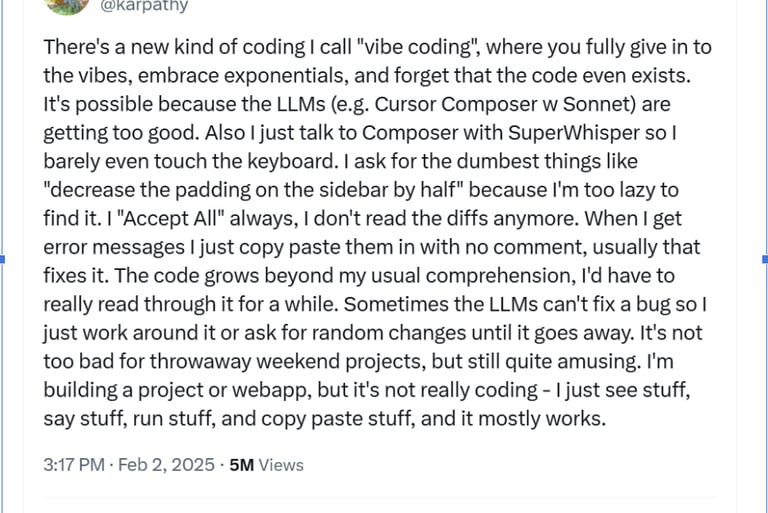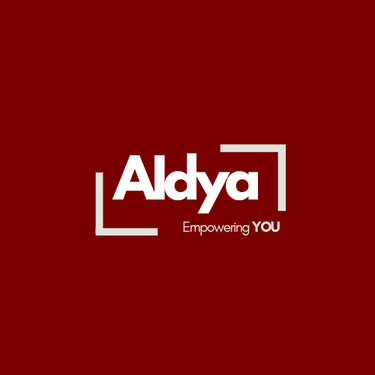Vibe Coding for Middle School Students: Transform Ideas into Code in 20 Minutes
Intro to Vibe coding and what can be interesting first projects to get middle schoolers started with vibe coding
6/18/20253 min read
Vibe coding is revolutionizing how middle school students learn programming. Instead of wrestling with complex syntax, students use natural language to describe what they want to build—and watch AI tools bring their ideas to life12. This approach keeps students in a creative flow while building real projects that matter to them.
What is Vibe Coding?
Vibe coding is a modern programming approach where students use natural language prompts to guide AI tools in generating code. Popularized by AI researcher Andrej Karpathy in 2025, it emphasizes staying in creative flow, embracing experimentation, and focusing on outcomes rather than perfect syntax34.
For middle school students, vibe coding removes traditional barriers to programming—no more getting stuck on semicolons or syntax errors. Instead, students can focus on what they want to build and why it matters56.
Why Vibe Coding Matters for Middle School Students
Removes Traditional Barriers
By eliminating syntax complexity, vibe coding lets students focus on creativity and problem-solving rather than memorizing programming rules39.
Develops Computational Thinking
Students learn to break down problems, recognize patterns, and think algorithmically—skills that transfer far beyond programming129.
Builds Confidence
Quick wins and immediate feedback help students see themselves as capable creators, not just consumers of technology89.
Prepares for Future Learning
Students who experience success with vibe coding are more likely to pursue advanced computer science courses in high school and beyond139.
Perfect Projects for Middle School Vibe Coding
✅ Great Project Ideas
Quick Win Projects (5-10 minutes)
These projects build confidence and demonstrate immediate success:
Rock, Paper, Scissors Game - Students describe the rules and see a working game instantly
Number Guessing Game - Classic logic exercise that teaches programming fundamentals
Mad Libs Generator - Combines creativity with simple programming concepts
ASCII Art Generator - Converts text into decorative visual patterns
Random Quote Display - Students curate and display inspiring quotes
Engaging Medium Projects (10-15 minutes)
Projects that show practical applications:
Homework Reminder App - Helps students organize assignments and deadlines
Lunch Menu Randomizer - Solves the daily "what should I eat?" dilemma
Study Timer - Pomodoro-style timer for focused work sessions
Digital Pet Simulator - Virtual pet that responds to student actions
Story Generator - Creates random prompts for creative writing
Why These Projects Work:
Immediate Visual Feedback - Students see results quickly, maintaining engagement78
Personal Relevance - Projects solve real problems students face daily
Creative Expression - Allows students to inject their personality and interests
Logical Thinking Development - Builds computational thinking without syntax barriers39
❌ Projects to Avoid
Overly Complex Technical Projects
Database Management Systems - Too abstract for middle school experience
Advanced AI Applications - Requires understanding of complex algorithms
Enterprise Software - Business logic is irrelevant to middle schoolers
Syntax-Heavy Programming
Low-Level System Programming - Defeats vibe coding's accessibility purpose
Complex Web Development - Multiple technologies can overwhelm students
Advanced Object-Oriented Programming - Abstract concepts difficult to visualize
Projects with Steep Learning Curves
Blockchain Applications - Too conceptually complex for the age group
Machine Learning Models - Requires mathematical foundation most students lack
Network Programming - Abstract networking concepts are hard to grasp
Why These Don't Work:
Lack of Immediate Gratification - Results aren't visible or understandable
Abstract Problem Domains - Students can't relate to problems being solved
Frustration and Discouragement - Complexity leads to giving up
Key Principles for 20-Minute Sessions
Start Simple, Build Confidence
Begin with projects that guarantee success. Students need to experience the "magic" of vibe coding before tackling challenges. As educational content experts note, "Simple is better than complex"—focus on clear, achievable outcomes15.
Make It Personal and Relevant
The best projects solve problems students actually have or express their interests. Whether organizing homework, creating digital art, or building simple games, relevance drives engagement46.
Prioritize Visual and Interactive Elements
Middle schoolers learn best when they can see and interact with their creations immediately. Projects that produce visual output or respond to user input are naturally more engaging than text-based outputs117.
Embrace the "Vibe" Philosophy
Don't worry about perfect code or optimization. The goal is experiencing the creative flow of bringing ideas to life through natural language descriptions. Students should focus on what they want to build, not how to build it perfectly39.
Build on Success
Start each session with a quick win, then gradually introduce more complex elements. This scaffolded approach maintains motivation while building skills89.
Getting Started with Vibe Coding
Recommended Tools
Replit - Browser-based coding environment perfect for vibe coding
Natural Language AI Tools - For translating ideas into code
Simple Project Templates - Starting points for common student projects
Ready to Transform Your Classroom?
Vibe coding offers an exciting opportunity to engage middle school students with programming in a way that feels natural, creative, and immediately rewarding. By focusing on what students want to build rather than how to build it perfectly, you can create an environment where every student experiences the joy and power of bringing ideas to life through code.
Start with simple projects, celebrate quick wins, and watch as your students discover they can be creators in the digital world. The key is keeping projects simple enough to complete in your timeframe while making them meaningful enough to inspire continued learning.


Built with AI and Humans Working in Harmony
